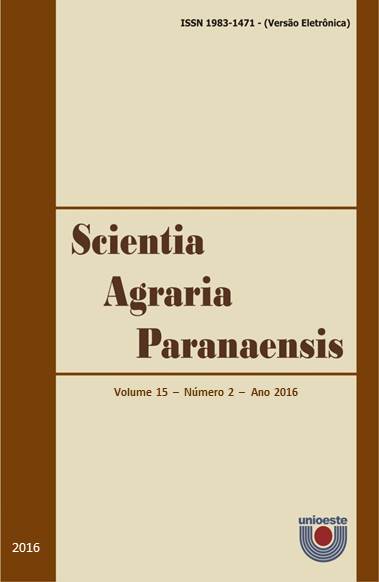Efeitos da suplementação com diferentes fontes de lipídeo na reatividade, estresse e concentrações plasmáticas de cortisol de bovinos confinados
DOI:
https://doi.org/10.18188/sap.v15i2.10902Palavras-chave:
cortisol, estresse, lipídeos, reatividade.Resumo
O objetivo deste estudo foi avaliar os efeitos da adição de lipídeos naturais e protegidos, na dieta de bovinos Nelore confinados, nas concentrações plasmáticas de cortisol e influência sobre reatividade animal. Foram utilizados 120 bovinos (366,9 ± 28,7), machos, não castrados provenientes de recria em pasto. O delineamento experimental foi inteiramente casualizado com medidas repetidas no tempo, composto por três tratamentos: controle - sem fonte de lipídeo, GDESP - com fonte de lipídeo natural a base de co-produto do algodão e GPROT - com fonte de lipídeo protegido rico em ácidos graxos poliinsaturados. Foram coletadas amostras de sangue antes do embarque dos animais (dia 0) e após o transporte para o confinamento, nos dias 1, 3, 7 e 14. Houve efeito significativo (p<0,05) entre o temperamento e dia da análise, assim como os níveis de cortisol e dia da coleta e tratamento que os animais receberam. No dia do embarque (dia 0), a média do escore de reatividade foi menor (p<0,05). No dia do desembarque (dia 1), os animais se apresentaram menos reativos (p<0,05). Nas coletas seguintes (dias 3, 7 e 14), houve um aumento progressivo na média dos escores de reatividade. O tratamento não influenciou na reatividade dos animais. Em relação ao cortisol, os resultados foram semelhantes à reatividade. Houve efeito (p<0,05) entre os tratamentos com inclusão de gordura protegida e gordura de fontes naturais, e o grupo controle. Os animais que receberam lipídeos na dieta tiveram níveis mais baixos de cortisol em relação ao grupo controle.
Downloads
Publicado
Como Citar
Edição
Seção
Licença
Aviso de Direito Autoral Creative Commons
Política para Periódicos de Acesso Livre
Autores que publicam nesta revista concordam com os seguintes termos:
1. Autores mantém os direitos autorais e concedem à revista o direito de primeira publicação, com o trabalho simultaneamente licenciado sob a Licença Creative Commons Attribution que permite o compartilhamento do trabalho com reconhecimento da autoria e publicação inicial nesta revista.2. Autores têm autorização para assumir contratos adicionais separadamente, para distribuição não-exclusiva da versão do trabalho publicada nesta revista (ex.: publicar em repositório institucional ou como capítulo de livro), com reconhecimento de autoria e publicação inicial nesta revista.
3. Autores têm permissão e são estimulados a publicar e distribuir seu trabalho online (ex.: em repositórios institucionais ou na sua página pessoal) a qualquer ponto antes ou durante o processo editorial, já que isso pode gerar alterações produtivas, bem como aumentar o impacto e a citação do trabalho publicado (Veja O Efeito do Acesso Livre).
Licença Creative Commons
Esta obra está licenciada com uma Licença Creative Commons Atribuição-NãoComercial-CompartilhaIgual 4.0 Internacional, o que permite compartilhar, copiar, distribuir, exibir, reproduzir, a totalidade ou partes desde que não tenha objetivo comercial e sejam citados os autores e a fonte.


